15 Types Of Peppers And When To Use Them
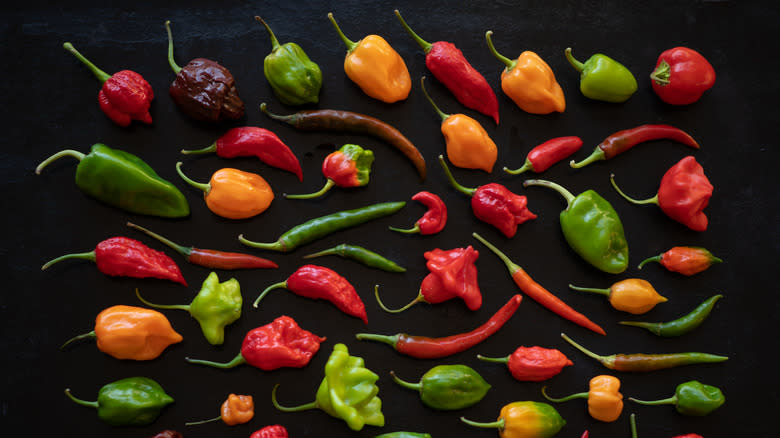
Pepper is almost always synonymous with "hot." Enjoying them is often a fine line -- you may be one of those who avoids them at all costs or someone who douses your food in hot sauce. But, with so many pepper varieties, you may be surprised to learn they aren't all that spicy. From mild, sweet bell peppers and banana peppers to intense, fiery Carolina reapers, peppers truly come in a range of flavors. Each variety has its uniqueness, making them versatile ingredients in a multitude of cuisines worldwide.
When it comes to the different kinds of peppers, it's all about understanding how they taste and how they can best be used. Some peppers are best suited for spicy cuisine and others add an extra element as a topping or garnish. It all depends on what your tastebuds can handle and how spicy you're willing to get. Here, we'll delve into several types of peppers, how to identify them when shopping, what they taste like, and ways you can incorporate them into your cooking.
Read more: 12 Vegetables And Fruits That Used To Look Very Different
Cayenne
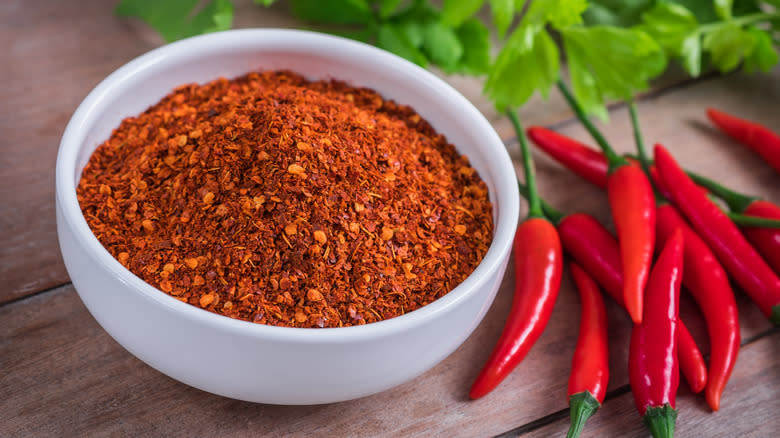
You may be more familiar with cayenne peppers in their ground, powdered form, which is often how it's seen. However, fresh cayenne peppers are also readily available and used in a variety of ways. These peppers are long, skinny, and bright red -- yep, like the emoji. Their heat comes from capsaicin, which is present in most spicy peppers and also has various antioxidants from beta carotene to vitamins A, C, and E. Oftentimes, it's used as a supplement because of its many health benefits. Aside from the antioxidants in capsaicin, cayenne peppers also have folate, potassium, magnesium, iron, and other important nutrients.
Cayenne typically ranges from 30,000 to 125,000 Scoville Heat Units (SHU) per the Scoville scale, which puts it around a medium level for spiciness. Most people can handle the heat of cayenne, which makes it a very easy pepper to use. Cayenne has a distinct peppery flavor, but it's also slightly fruity and is ideal for adding to eggs or chocolate, especially in powdered form. If you're using whole cayenne peppers, they are a delicious addition to chili, sauces, soups, a Bloody Mary, and really any cuisine that you want to have an extra kick, particularly Asian cuisine.
Bell Peppers
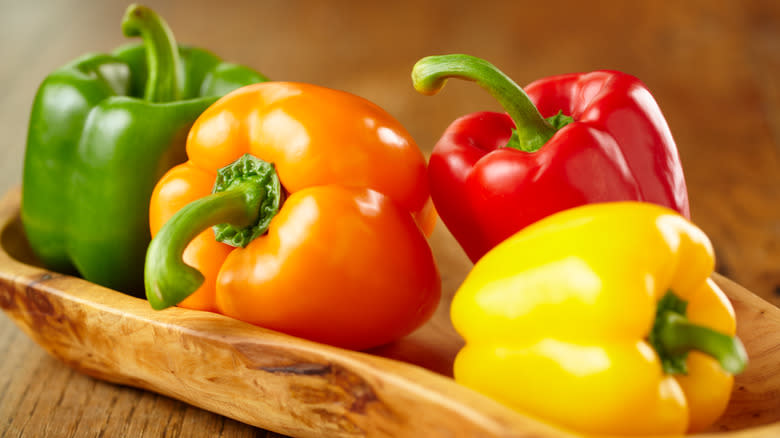
Bell peppers, or sweet peppers, are perhaps one of the most bearable types of pepper (spice-wise). A relative of chili peppers, these peppers (also known as Capsicum annuum) range in size from petite and slightly rounded to large and bulbous -- like the ones known for stuffed peppers. They contain several essential vitamins and are particularly rich in vitamin C, but are typically not spicy at all. Bell peppers also vary in color, from green when they are technically underripe to yellow, orange, and red. Even though they aren't nearly as common, bell peppers are also found in shades of purple, white, and brown.
If you've ever taken a bite of raw or cooked sweet peppers, you know they have a great crunch. Typically, you should remove the seeds because they can taste bitter, but they aren't harmful by any means. Red bell peppers are certainly the sweetest, with yellow and orange following close behind, and green bell peppers are usually more bitter. As far as cooking bell peppers, they are incredibly adaptable. You can easily eat them raw on a veggie tray, stuff them, or sauté them. They're great for pasta, goulash, soups, or including as a side, like in this recipe for roasted fish with sweet peppers.
Piquillo Peppers
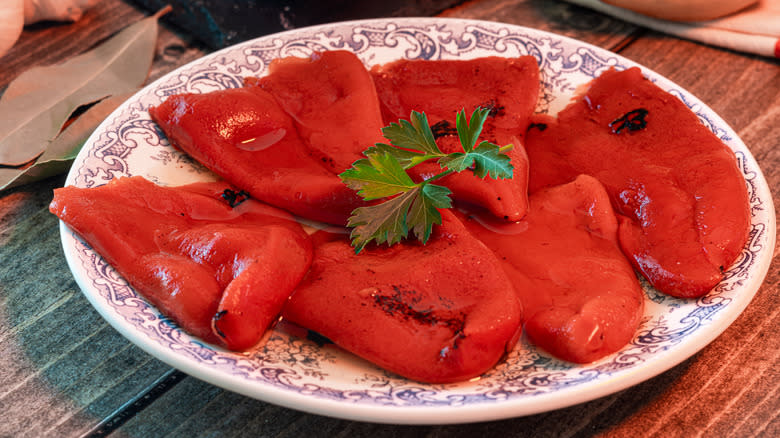
Piquillo peppers are a type of red chili pepper native to the northern region of Spain, particularly the Navarre region. Spanish for "little beak," piquillo peppers are shaped like exactly that! Oftentimes, they are sold in jars after they've been fire-roasted, peeled, and de-seeded. On the Scoville scale, they sit at 500 to 1000 SHU, which is remarkably low. Despite being a pepper, they aren't extremely hot. Like bell peppers, they have a sweet bite to them, but they are also known to be tangy in flavor.
Their triangular, almost heart-shaped form makes them ideal for stuffing. This is probably one of the most common uses for them, and they work well with fillings such as cheese, meat, seafood, or vegetables. You can also pickle them, fry them, or roast them, all of which will intensify their mild flavor. Piquillo peppers are tasty when cooked in paella or added to eggs, sandwiches, salads, or pizza.
Chipotle Peppers
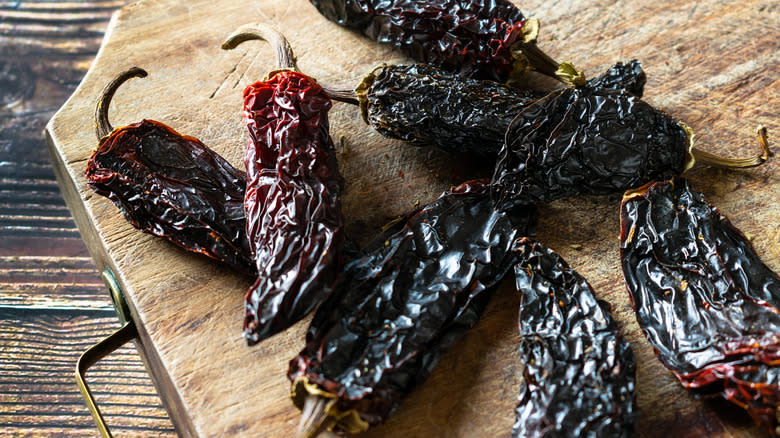
Chipotle peppers are red jalapeño peppers that have been dried and smoked. Typically, they can be purchased whole, canned, or in ground form. These peppers are an integral ingredient in Mexican and southwestern cuisine, known for their smoky, earthy flavor and moderate heat. Seeing as how they are made from jalapeño peppers, they have the same level of heat -- 5,000 to 10,000 SHU. You can also make them at home by smoking your own jalapeños.
In particular, chipotle peppers are often used to make adobo sauce. Besides that, they're also a good pepper for tacos, fajitas, and chili. As a powder, chipotle makes a great rub or marinade, or a spice for eggs and baked foods like cornbread or chocolate desserts. When cooking with chipotles, it helps to pay attention to the heat level. While regular chipotle peppers are more common, morita chipotle peppers are a variant that is typically spicier.
Tabasco Peppers
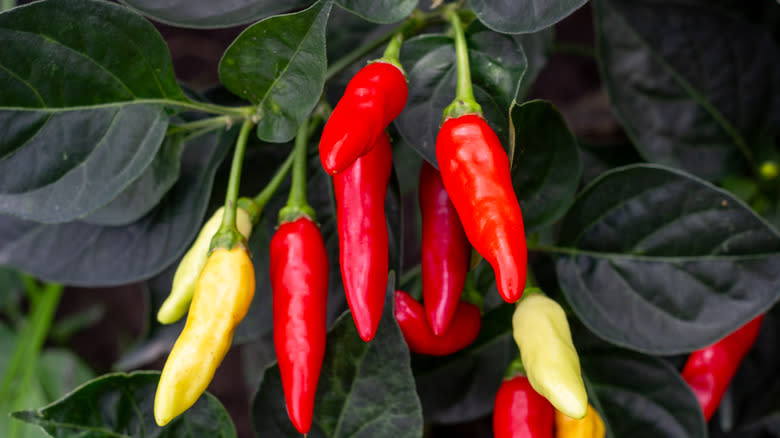
You've likely seen Tabasco peppers in the infamous hot sauce, but these tiny peppers can be used in many more ways. Native to Mexico, these peppers come in around 30,000 to 50,000 SHU, which gives them an average level of heat close to that of cayenne. While Tabasco sauce is pretty heavy on salt, the actual peppers boast many health benefits. Like other peppers, they contain vitamins like A and C as well as a small amount of dietary fiber and some protein.
Surprisingly juicy for their smaller size, they pack a burst of flavor perfect for various recipes, particularly Mexican cuisine. Even though they have some heat, they're also somewhat smoky and can taste fruity once they're ripe and red. You can make your own hot sauce with the peppers at home, with a simple mixture of the peppers, salt, and vinegar. Moreover, the peppers are great in marinades, dips, salsas, and even cocktails. Tabasco peppers are also ideal for stuffing or pickling if that's more your style.
Anaheim Peppers
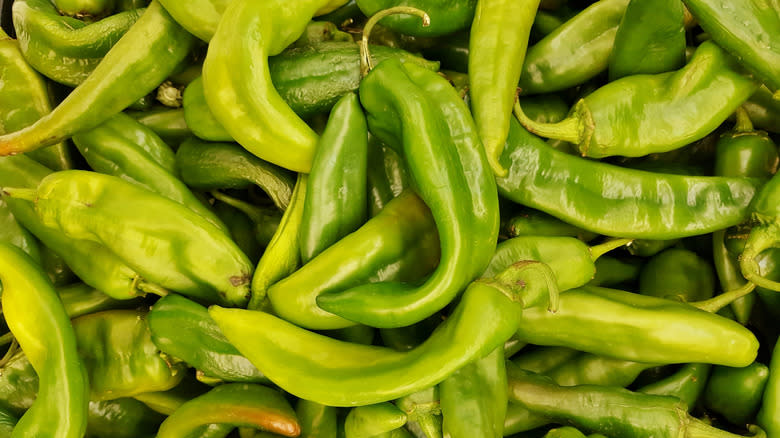
As their name suggests, Anaheim peppers are named for the city in California but are sometimes called Magdalena, California chili, or New Mexico peppers. With the Scoville scale placing them around 500 to 2,500 SHU, they're fairly mild, making them an ideal pepper if you don't like a lot of heat. And, much like bell peppers, they have a sweeter, fruity flavor that makes them perfect for even snacking. When shopping for them, they might look similar to jalapeño peppers, as they're both green and oblong, but Anaheim peppers tend to be sharper in shape than jalapeños, which have a rounder top to them.
One of the most popular uses of Anaheim peppers is in chiles rellenos, a Mexican dish where roasted and peeled peppers are stuffed with cheese, meat, or a mixture of both. They are then dipped in batter, fried, and served with salsa or sauce. Anaheim peppers are also good for stuffing and roasting. If needed, they are a good substitute for poblano peppers.
Bird's Eye Chile Pepper
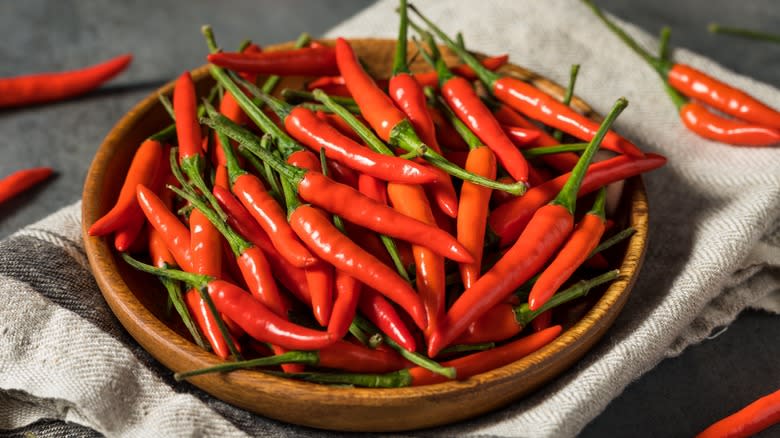
Sometimes called Thai chile peppers, bird's eye chile peppers are extremely common in Southeast Asian cuisine from Thai food to Vietnamese cuisine. This variety is known for its bold, fiery flavor and intense heat, ranging from 100,000 to 225,000 SHU. To help you understand just how spicy that is, a jalapeño pepper has a score of 2,500 to 8,000 SHU. Small and slender, these peppers typically are bright red (often called red Thai peppers) or green, with a sharp, pointed tip resembling a bird's eye.
You can buy these peppers whole and dried, in powder or flake form, or even as a paste. You'll typically find these peppers in curries, sambals, stir-fries, and any spicy Southeast Asian dishes. It's also used to make prik nam pla (or nam pla prik), a traditional dipping sauce made in Thailand with bird's eye chile peppers, garlic, fish sauce, and lime juice. That sauce is often served in nam prik ong, a Thai appetizer.
Serrano
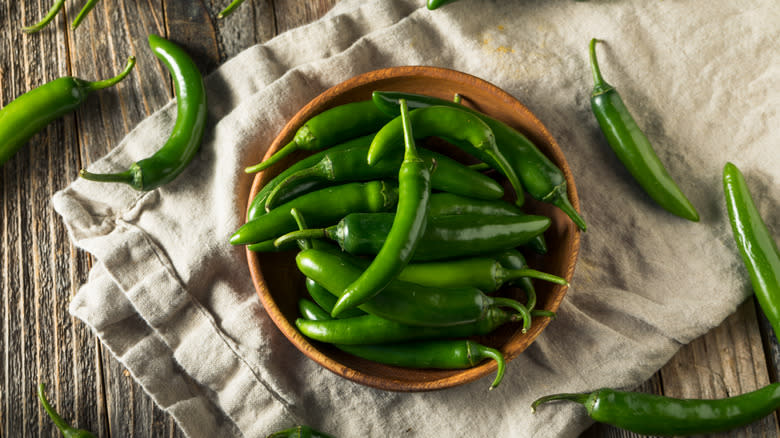
Looking almost like skinny, little jalapeños, serrano peppers are definitely hot, but still a versatile variety. They're significantly spicier than jalapeños, with a score of 10,000 to 25,000 SHU. However, their earthy, mild peppery flavor is rather similar to that of a jalapeño, making them a decent substitute for one another. Unless it comes to stuffing -- serrano peppers aren't optimal for that because of their slender size. Just like other varieties, serrano peppers range in color from a ripe red, a lesser ripe orange and yellow, and an unripe green -- finding green serrano peppers is very common. Typically, they are hotter when they are smaller and more mild if they are underripe. They're found at many larger grocery stores as well as Mexican grocery markets and can usually be purchased fresh or dried.
In your cooking, serrano peppers are perfect for topping pizza and tacos and adding to guacamole, salsa, or chili. They also work well sautéed as a side or in stir-fry or other rice dishes. We recommend using them in a spicy serrano pico de gallo.
Scotch Bonnet
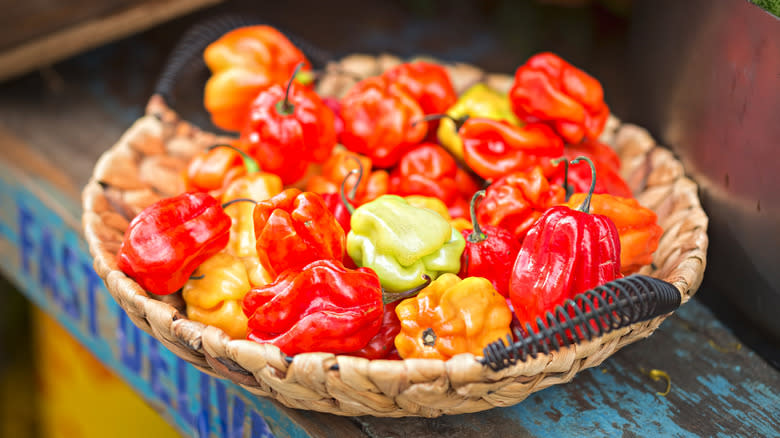
Scotch bonnet peppers are incredibly common in the Caribbean, especially in Jamaica where they're primarily grown. This variety is one of the more intense peppers, with a Scoville rating of 150,000 to 325,000 SHU. Despite their Caribbean heritage, their name is derived from their shape -- on the vine, they resemble a Scottish bonnet. Red is ripe, but these peppers transition through shades of green and orange as they grow.
When cooking Scotch bonnets, beware. They're about as hot as a habanero, and probably not a good starter option if you don't like a lot of spice. These peppers are key for dishes like jerk chicken and pepper sauces. Some other traditional Caribbean dishes that use this beloved pepper are callaloo and pepperpot stew. Depending on how you enjoy a sweeter kind of heat, Scotch bonnets make a great salsa, curry, chutney, or hot sauce for dipping as well as seasoning meat.
Banana Peppers
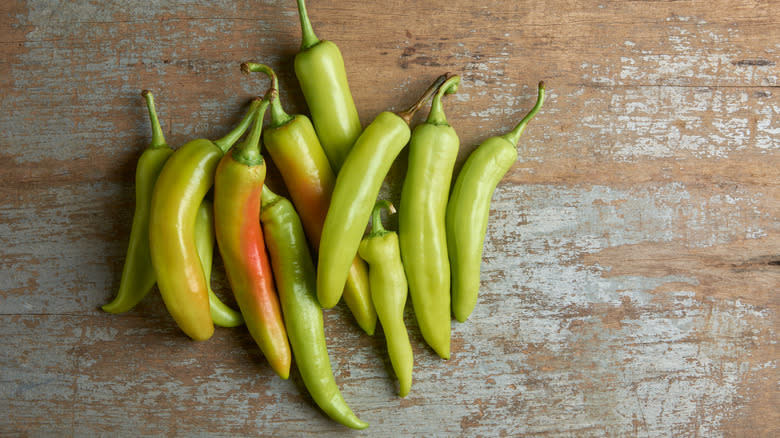
You've likely seen banana peppers, if not on a pizza, then in the produce aisle. Because of their mild, slightly sweet flavor that is manageable for most, banana peppers are very common. Just as their name indicates, this variety is usually yellow by the time they're picked, but they ripen to shades of orange and red just like other peppers. Only going up to 500 Scoville Heat Units, this variety is rather tame. Perhaps it's good they won't make you sweat, as they also have many health benefits including a good amount of dietary fiber and vitamin B6, as well as potassium, folate, and calcium.
Very often, banana peppers are pickled or eaten fresh. You may see them on pizza, sandwiches, salads, or wraps. They're also a good choice for stuffing or frying. However, there are a multitude of unique ways to use banana peppers, from the typical grilling and roasting to incorporating them into salsas, relishes, and more.
Poblano
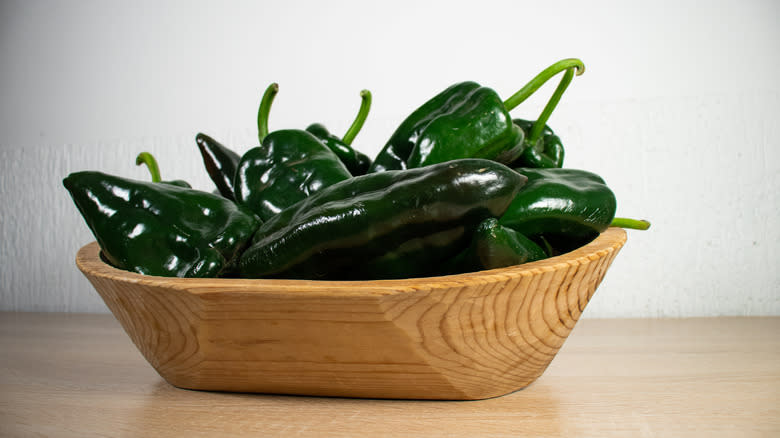
Typically found fresh, dried, or powdered, poblano peppers are a kind of chili pepper often viewed as a less spicy jalapeño. As far as their heat level, it ranges from 1,000 to 1,5000 SHU, which is pretty low. Green poblano peppers are generally less spicy than red poblanos, but when red poblanos are dried (called ancho chiles), they are smokier in flavor. Containing capsaicin adds to their nutritional value, as it's a powerful antioxidant and these peppers also have a lot of vitamin C -- about 134% of the daily recommended.
Besides being a staple in Mexican cuisine, poblano peppers can be used in many different ways. Slightly sweet, they're the perfect addition to relishes and salsas, but they're also a unique element for cornbread. In general, they can be used universally in soups, chilis, casseroles, and more. They're great in this grilled salmon with tomato-olive salsa and poblanos and also think they're worth a try in this recipe for black beans and roasted corn with poblano.
Ghost Pepper
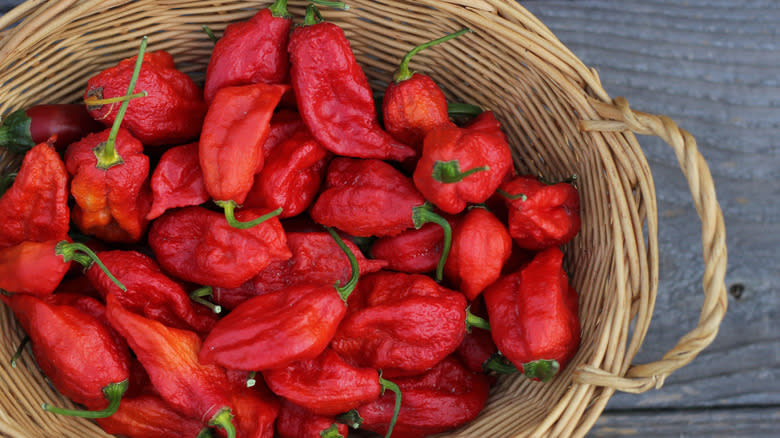
If you're already sweating, don't worry -- so are we. Ghost peppers are notoriously hot. In fact, they are one of the spiciest chile peppers on earth. They've become the fuel for contests everywhere, where just trying a bite has become a huge challenge. To put it into perspective, ghost peppers range from 600,000 to over a million SHU. Seeing as how the hottest habanero peppers only reach 577000 SHU, that's incredibly spicy! If you can get past the general heat, these peppers are said to have a smoky taste. Apparently, the hotter the pepper, the scarier it looks, and ghost peppers are no exception. While their coloring isn't different from other varieties, their skin is deeply wrinkled, giving them a distinct and kind of worrisome appearance.
Many might find this pepper far too hot to eat, but it's actually found as a flavor for chips, salsas, hot sauces, and candy -- even Dunkin' Donuts released a ghost pepper donut for Halloween a few years back. If you're brave enough, try it in curries or chutneys, or even join a challenge to simply try eating one.
Habanero
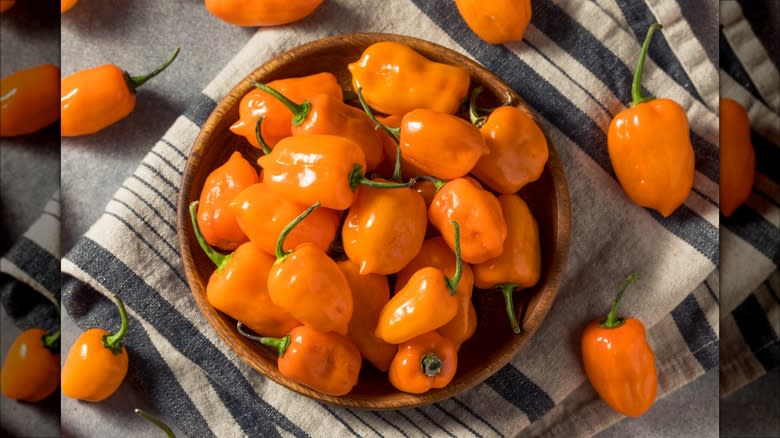
Perhaps because it's on the hotter end of peppers, habaneros are often used for comparison when discussing spiciness. These chili peppers are hot and fruity, sitting between 100,000 to 577,000 SHU, with the hottest, Habanero Red Savina, reaching up to 577,000 SHU. Before super hot peppers came into the picture, like ghost peppers and Carolina reapers, habaneros were reigning supreme as one of the spicier varieties. Some of the most common habaneros (and those lowest on the Scoville scale) are identifiable by their orange color and small, round body. Despite their spicy flavor, they do still offer plenty of vitamins A and C.
Because of their intense heat, they provide a complement to sweeter recipes such as salsa, chutney, and jam, especially if they're made with tropical fruits like pineapple or mango. They can also be pickled, infused into an oil, or incorporated into dips and sauces. If you're down for the heat, try making some pineapple habanero wings.
Pepperoncini
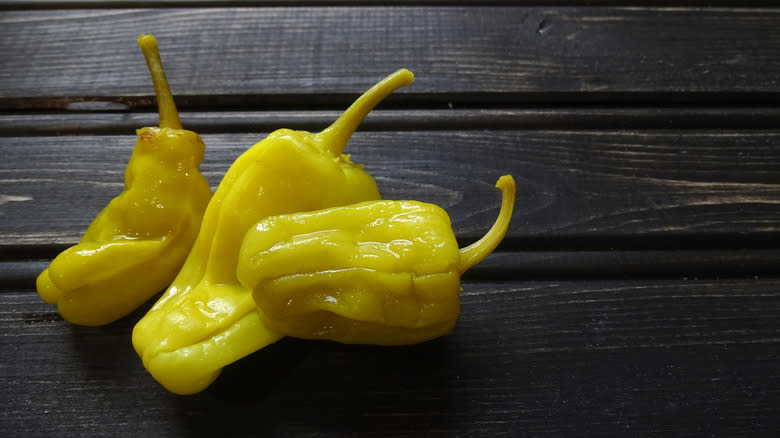
Pepperoncini is a type of chili peppers sometimes called sweet Italian peppers, Greek peppers, or Tuscan peppers. Even though they're commonly used in Mediterranean cuisine, they are often mistaken for banana peppers. When it comes to pepperoncini versus banana peppers, it really comes down to appearance. Just like banana peppers, pepperoncini peppers are sweet, mild, greenish-yellow, often pickled, and also found on sandwiches and salads. However, pepperoncini peppers are typically more wrinkled and more robust in shape than banana peppers.
Even though pepperoncini peppers are different from banana peppers, their uses are fairly similar. You can use this variety in soups, salsas, arrabbiata sauce, or as garnishes. More frequently, they are found in Mediterranean dishes involving grilled chicken, as well as Greek salad and antipasto boards alongside cheeses, cured meats, tomatoes, and nuts. If you want to switch it up from the norm, try them in this recipe for slow cooker Mississippi pot roast.
Carolina Reaper
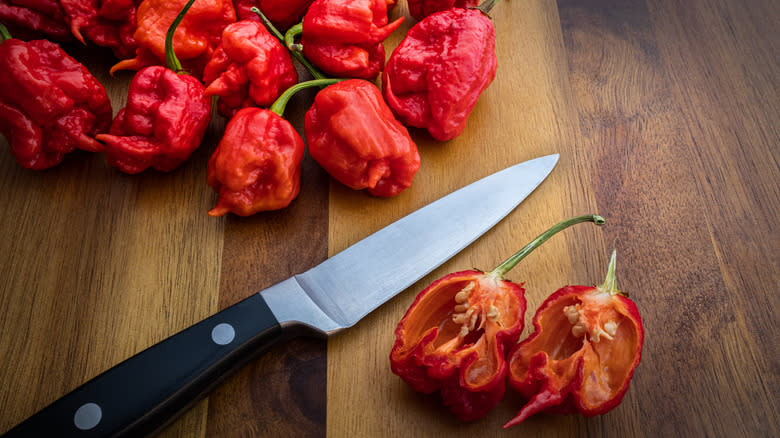
The hottest is saved for last and Carolina reaper peppers definitely deserve the spot. On the Scoville scale, they range from a whopping 1,500,000 to 2,200,000, which is more than twice as hot as ghost peppers. Suffice it to say, they may not be at the top of your grocery list. This may be for the best, as they're difficult to find, but relatively simple to grow. Just like ghost peppers, their skin is shriveled but they still have a bright, red color. Although they are extremely spicy, they are known to have a sweet flavor, too.
If you like a good challenge, you can definitely add Carolina reapers to your dishes. Still, it's best you always handle these peppers with extreme caution and use them in small amounts as you figure out the right level of heat for your recipes. Also, it's suggested never to eat them raw, even if YouTubers keep trying it live. Puckerbutt Pepper Company uses Carolina reapers in one of the world's spiciest hot sauces. At home, you can use them in your own hot sauces, salsa, stews, chicken wings, Asian noodle recipes, and spicier cuisines like Indian and Mexican.
Read the original article on Daily Meal.

